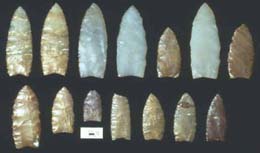Archaeological finds in various locations across Washington have helped scientists learn about how the earliest residents of this state lived. (This essay was written for students in third and fourth grade who are studying Washington State History and for all beginning readers who want to learn more about Washington. It is one of a set of essays called HistoryLink Elementary, all based on existing HistoryLink essays.)
Clues to the Past
Native Americans have lived in Washington for thousands of years. Recorded history -- history that is written down -- goes back only for several hundred years. To learn about how people lived before that, we have to look for other clues. Stories passed down from generation to generation within the tribes are important. They help us understand tribes' cultures and traditions. Another source of information is ancient artifacts -- items made by people. Museums are filled with hand-made baskets, many kinds of tools and weapons, articles of clothing, and other artifacts that tell us something about the lives of different Indian groups.
The objects that the First People used in their daily lives were made from natural materials and most were used on a regular basis. As a result, the objects wore out, broke, or were thrown away. Luckily, there have been some important archaeological finds in the state. These discoveries have helped scientists learn even more about the lifestyles of these earliest residents of what is now Washington.
In 1987, workers were putting a sprinkler pipe in an apple orchard in East Wenatchee. They had only dug down about 20 inches when they made an exciting discovery. They had uncovered a pit filled with prehistoric tools and more than a dozen stone spearheads. Some time passed before a team of scientists from Washington State University arrived to examine the artifacts. They soon realized that this was a very important find.
The spearheads found in the apple orchard were a distinct style of hunting tool called a Clovis point. The name "Clovis" refers to a small town in New Mexico where many similar early artifacts were found. Clovis points were made by prehistoric people more than 11,500 years ago to help bring down huge mammals such as the giant sloth, mammoth, and mastodon. Studies also showed that the pit had ash from an ancient volcanic eruption mixed in with the tools. This ash helped the scientists decide how long the tools had been buried and how old they were. They said the tools were more than 11,500 years old. At the time this find was the oldest evidence of human life found in Washington and some scientists even thought it was the oldest in all North America. But since then evidence of humans living in North and South America even longer ago has been found in different places, including in Washington.
The dig in East Wenatchee turned up more Clovis points than had ever been found in one spot before. In addition to spear points, scientists also discovered axes, choppers, knives, scrapers, and an engraving tool. More than 70 artifacts were uncovered in the first two digs. Some experts believed that this set of tools was buried by a hunting party to be used during a future hunt.
Members of the nearby Colville Confederated Tribes became worried that the scientists might be disturbing a tribal burial ground. They wanted the digging to stop. The archaeological site was purchased by the Washington State Historical Society. They agreed to not dig again for 15 years -- until 2007. The site was protected by concrete slabs, covered with dirt, and replanted with apple trees.
In 2005, another important archaeological site was discovered -- this time in Spokane. While digging a deep pit for a sewer tank in People's Park, workers noticed unusual items mixed in with the dirt and rocks. Tools, bones, and other ancient artifacts had been uncovered. The workers contacted city officials. Scientists from Eastern Washington University arrived at the site to supervise the dig. Members of the Spokane Tribe who had once lived on the land also helped.
There were no human remains found in People's Park, but more than 60,000 artifacts were recovered. Scientists decided that this site was once a summer hunting camp. Bones of animals that were difficult to catch during winter months helped support that theory. Rocks used as weights for nets gave clues to how fishing technology had improved over time. A spear point from Oregon told scientists that there had been trading around the region for a great many years. Scientist dated the oldest artifacts at this site as being from 8,000 years ago. This made Spokane the oldest continually occupied place found in Washington so far.

